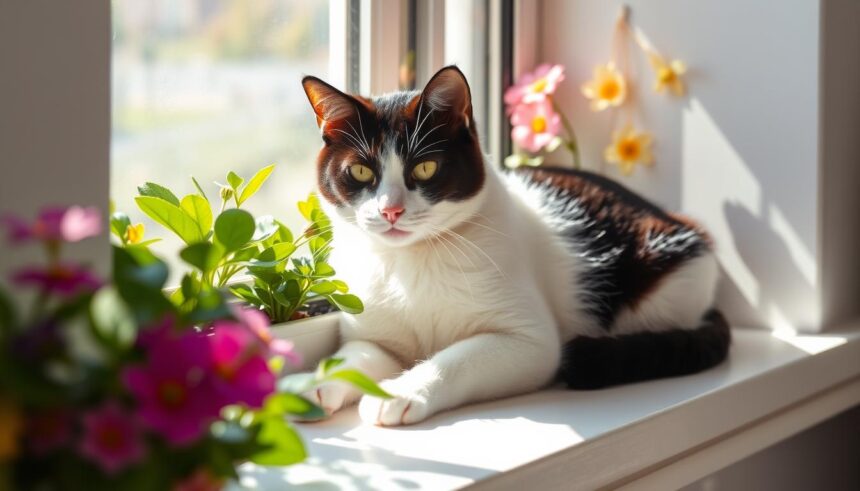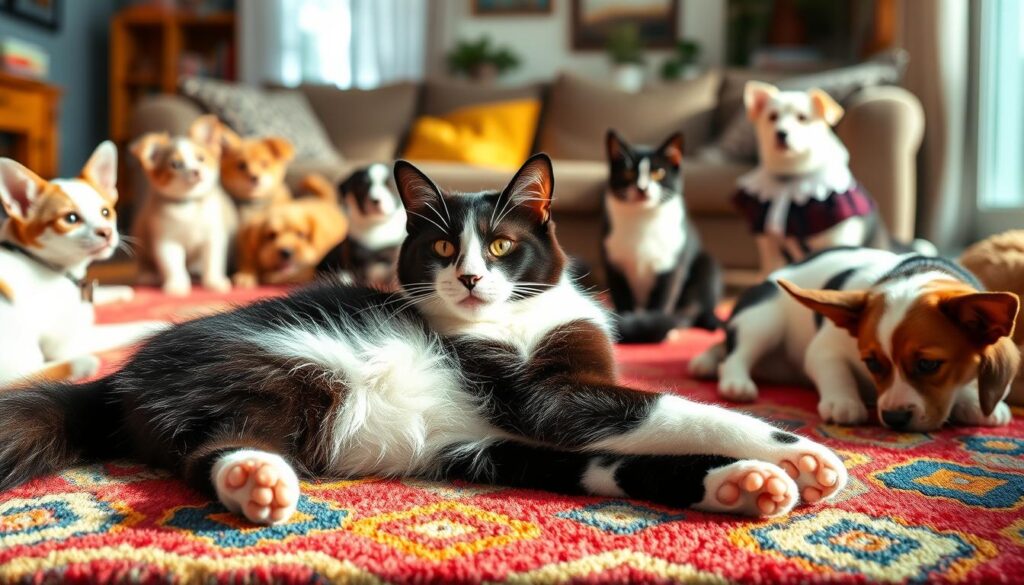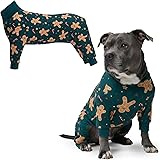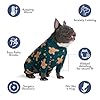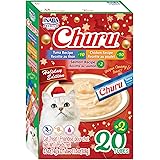Tuxedo cats can live up to 20 years, making them great long-term friends. Their black and white coats look like a tuxedo, which is very charming. For more about these cats, check out tuxedo cat facts. Tuxedo kittens are very popular and add a special touch to any family. Each tuxedo cat is unique because the pattern is found in many breeds.
Tuxedo cats are smart and love to be around people. They make great friends in any home. The price of a tuxedo kitten can range from $500 to $2,000, depending on the breed. However, mixed breed tuxedo cats are more affordable and just as loving.
Key Takeaways
- Tuxedo cats can live up to 20 years, depending on the breed and individual factors.
- The tuxedo cat bicolor pattern is not exclusive to a single breed, but can be found in various breeds like Maine Coon, Scottish Fold, and Manx.
- Tuxedo cats are known for their intelligence and social behavior, making them excellent companions in households.
- Tuxedo cats come in various colors besides black and white, such as gray, silver, orange, and tortoiseshell with white spots.
- Tuxedo cats are not a specific breed, but rather a coat pattern found in various breeds like American Shorthair, British Shorthair, and Maine Coon, as well as in mixed-breed cats.
- Tuxedo cats are social animals that get along well with people and other pets, exhibiting outgoing and loving behaviors.
- The cost of a tuxedo kitten can vary, with purebred tuxedo cats costing between $500 to $2,000, and mixed breed tuxedo cats being more affordable options for adoption.
Understanding the Tuxedo Cat Bicolor Pattern
The tuxedo cat pattern is a unique and striking coat pattern that has captured the hearts of many cat lovers. It is characterized by a combination of black and white fur, creating a distinctive “tuxedo” effect. This pattern is due to a specific genetic combination that affects melanin production, leading to the black and white coloration.
The tuxedo cat pattern is not exclusive to any particular breed. It can be found in various breeds, including the American Shorthair, British Shorthair, and Maine Coon. The key characteristic is the presence of low-to-medium grade white spotting on the coat, often seen on the paws, face, throat, chest, and tail.
Definition of Tuxedo Cat Markings
Tuxedo cat markings are defined by the presence of two colors: black and white. The black coloration can range from a deep, rich black to a lighter, more muted tone. The white coloration can be pure white or have a slightly creamy tint. This combination creates a unique and eye-catching pattern that is characteristic of the tuxedo cat.
Historical Background
The origins of the tuxedo cat pattern are not well-documented. However, it is believed to have originated in Europe, where it was highly prized for its unique appearance. Today, the tuxedo cat pattern can be found in a variety of breeds and is highly sought after by cat fanciers.
Common Misconceptions
Despite their popularity, there are several common misconceptions about tuxedo cats. One of the most prevalent is that they are a specific breed, when in fact, the tuxedo cat pattern can be found in a variety of breeds. Another misconception is that tuxedo cats have specific personality traits or characteristics, when in fact, their individual personalities are shaped by their breed and personal history.
- Low-to-medium grade white spotting on the coat
- Black and white coloration
- Unique, eye-catching pattern
- Not exclusive to any particular breed
In terms of tuxedo cat characteristics, it’s worth noting that they do not have specific personality traits or characteristics associated with their coat coloring. Instead, their individual characteristics depend on their breed and personal history. As for tuxedo cat markings, they are a result of a specific genetic combination that affects the production of melanin, resulting in the black and white coloration.
Physical Characteristics of Tuxedo Cats
Tuxedo cats are famous for their tuxedo cat appearance. They have a bicolor pattern that looks like a formal tuxedo. Their coats can be black and white, and they show different patterns like locket, tuxedo, and more.
These cats are usually medium-sized. They weigh between 8-12 pounds and are quite muscular. They can have eyes in colors like green, gold, copper, and blue.
Some common traits of tuxedo cats include:
- Short or long coats
- Medium to large size
- Muscular build
- Various eye colors
Tuxedo cats are not rare. They can be found in breeds like Domestic Shorthair and Maine Coon. Their unique look and charming personality make them a favorite among cat lovers.
| Breed | Pattern | Size |
|---|---|---|
| Domestic Shorthair | Tuxedo, Locket, Mask-and-mantle | Medium |
| Turkish Van | Van, Harlequin | Large |
| American Shorthair | Tuxedo, Cap-and-saddle | Medium |
The Distinctive Eye Colors of Tuxedo Cats
Tuxedo cats are known for their striking appearance. Their eye color is one of the most distinctive features. Common colors include gold, green, and blue. Each cat’s eye colors are unique, adding to their charm and personality.
The eye colors of tuxedo cats come from genetics. Factors like breed and ancestry also play a role. Some cats have deep, rich gold eyes, while others have bright, sparkling green eyes. Blue eyes are also common, ranging from pale sky blue to deep navy blue.
Common Eye Color Variations
Some common eye color variations in tuxedo cats include:
- Gold: a deep, rich gold color that is often associated with a warm and friendly personality
- Green: a bright, sparkling green color that is often associated with a curious and playful personality
- Blue: a pale sky blue to deep navy blue color that is often associated with a calm and gentle personality
Genetic Factors Affecting Eye Color
The genetics of eye color in tuxedo cats are complex. Multiple genes interact to produce the final eye color. Melanin, a pigment, is controlled by these genes, determining the eye color.
Rarity and Genetics Behind Tuxedo Cats
Tuxedo cats are not rare. They are common in many cat breeds, except a few. The genetic mutation for their coat is linked to the white spotting “S” gene. Cats with one dominant and one recessive “S” gene (Ss) often look like tuxedo cats.
The tuxedo pattern is not rare, but its frequency changes by region and population. To find out more about tuxedo cat facts, including their genetics and rarity, check online resources.
Some important facts about tuxedo cat genetics and rarity are:
- Tuxedo cats have a bicolor design with black and white.
- They can also have other colors, like orange and white or gray and white.
- The bicolor pattern is more common in breeds like Domestic Shorthair, Turkish Van, and Maine Coon.
The rarity of tuxedo cats is due to their genetics. Knowing about tuxedo cat genetics helps us understand their unique traits.
Gender Distribution in Tuxedo Cats
Tuxedo cats are famous for their unique bicolor coat. But, do they have more males or females? The answer is, they have an equal number of both. This shows that tuxedo cat gender doesn’t affect their coat pattern. Data shows that tuxedo cats come in equal parts male and female, showing a balance in this color pattern.
Male and female tuxedo cats don’t differ much in behavior or traits. Both are smart, playful, and loving. To learn more about tuxedo cats, check out tuxedo cat facts and see their special qualities.
Male vs. Female Prevalence
Male and female tuxedo cats are just as common. This is because their coat pattern isn’t tied to their gender. So, tuxedo cat male female cats are found in equal numbers. This makes them a favorite among cat lovers.
Gender-Specific Traits
Some owners say their tuxedo cat male or tuxedo cat female has special traits. But, these traits aren’t just about gender. They can change a lot from one cat to another.
Intelligence and Personality Traits
Tuxedo cats are known for their charming and affectionate personality. They are intelligent, playful, and social. This makes them wonderful companions. Their tuxedo cat intelligence is 200% higher than other cat breeds. They are seen as intelligent and good at solving problems.
Some of the key characteristics of tuxedo cats include:
- Curiosity and a love for exploring their surroundings
- Affectionate nature and a strong bond with their owners
- Playfulness and energy, with a balance between activity and relaxation
- Intelligence and adaptability, making them easy to train and interact with
Tuxedo cats have a unique tuxedo cat personality. This can vary from cat to cat. Some are more energetic and playful, while others are more laid-back and affectionate. Their intelligence, curiosity, and social nature make them great companions for families and individuals alike.
Overall, tuxedo cats are a beloved and popular breed. Their unique characteristics and charming personalities have won many hearts. They continue to be a popular choice as pets.
Lifespan and Health Considerations
Tuxedo cats are known for their unique look. But, their tuxedo cat health and lifespan are also key. On average, a Tuxedo cat lives about 15 years. Some can even live into their late teens and early 20s with good care and vet visits.
Several things can affect a Tuxedo cat’s lifespan. These include what they eat, where they live, their weight, if they’ve been neutered, their genes, and how well they get healthcare. Proper diet and living indoors can help them live longer. Also, managing their weight, being neutered, and having diverse genes are important for their health.
Health issues in Tuxedo cats vary by breed. But, with regular vet visits and a healthy lifestyle, many can live into their teens. Knowing about potential health problems and taking steps to prevent them can help your Tuxedo cat live a long, happy life. By understanding what affects tuxedo cat health and promoting a healthy lifestyle, you can ensure your cat’s happiness and well-being.
Average Life Expectancy
Tuxedo cats can live up to 15 years, depending on their breed and individual factors. With proper care and attention, some Tuxedo cats have been known to live into their early 20s.
Preventive Care Tips
- Provide a balanced and nutritious diet
- Ensure regular veterinary check-ups
- Maintain a healthy weight and body condition score
- Keep your Tuxedo cat indoors to protect them from outdoor hazards
By following these tips and being mindful of your Tuxedo cat’s health, you can help them live a long and happy life. Always prioritize your cat’s tuxedo cat health and wellbeing. Seek vet attention if you have any concerns.
The Social Nature of Tuxedo Cats
Tuxedo cats are known for their friendly and outgoing personalities. They are perfect for families and individuals who want a social pet. Their desire to interact with humans and other pets is strong, forming close bonds.
These cats are very affectionate, making them tuxedo cat friendly. They love to play and get attention from their owners. Some common traits include:
- Playful and energetic, with a love for interactive toys and games
- Affectionate and loving, with a strong desire for human interaction
- Intelligent and curious, with a tendency to explore their surroundings
- Loyal and devoted, with a strong bond to their owners
Tuxedo cats are also intelligent and adaptable. They are easy to train with positive reinforcement. They can do well in many living situations, from apartments to homes with yards.
Overall, tuxedo cats are perfect for anyone wanting a friendly pet. Their friendly and affectionate nature makes them a joy to have around. Their intelligence and adaptability also make them easy to care for.
| Tuxedo Cat Traits | Description |
|---|---|
| Social Nature | Friendly, outgoing, and affectionate |
| Intelligence | Highly trainable and adaptable |
| Energy Level | Playful and energetic, with a love for interactive toys and games |
Breeding and Origins
Tuxedo cat breeding mixes certain genetic traits for the black and white look. The tuxedo cat’s roots come from breeds like the Maine Coon, American Shorthair, and Scottish Fold. These breeds add to the tuxedo pattern with their unique genes.
Some common parent breeds used in tuxedo cat breeding include:
- Maine Coon
- American Shorthair
- Scottish Fold
- Norwegian Forest cat
The genes that make the tuxedo pattern are complex. They involve many genes working together. Knowing these genetic combinations is key for breeding tuxedo cats. It helps breeders get the right coat pattern and color.
The history of tuxedo cats also shapes their origins. Ancient Egypt first showed tuxedo cats. They were prized for their looks and thought to bring luck.
| Breed | Coat Pattern | Color |
|---|---|---|
| Maine Coon | Tuxedo | Black and White |
| American Shorthair | Tuxedo | Black and White |
| Scottish Fold | Tuxedo | Black and White |
In summary, tuxedo cat breeding and origins are complex. They involve specific genetic traits and breeds. Understanding these factors helps breeders and lets us appreciate the rich history of this unique breed.
Cost and Value Considerations
Thinking about getting a tuxedo cat? It’s key to know the costs. The tuxedo cat cost changes based on the breeder, bloodline, and where you live. Are tuxedo cats pricey? It really depends on what you choose. You might find a tuxedo cat at a shelter for less money or pay more for one from a breeder.
The tuxedo cat price can be anywhere from $1,000 to $3,000. This depends on the breed and its background. Here are some costs to think about:
- Adoption fees: $110 to $225
- Breeder prices: $1,000 to $3,000
- Initial setup and supplies: $720 to $3,000
- Monthly expenses: $193 to $847
Remember, there are ongoing costs too. You’ll need to budget for health care, grooming, and fun activities. Knowing the full tuxedo cat cost and tuxedo cat price helps you decide. It ensures you’re ready to give your new pet the best life.
Care Requirements and Grooming Needs
Tuxedo cat care means regular grooming to stop fur matting and tangling. Learning to spot skin issues is key for their health. Their coat, nails, ears, and teeth need regular care.
Key parts of tuxedo cat care include a balanced diet, fresh water, and a comfy home. Regular vet visits are also important to catch health problems early. Tuxedo cats love people, so spending time with them is crucial for their happiness.
Here are some grooming tips for tuxedo cats:
- Brush their coat often to avoid matting and tangling
- Trim their nails every few weeks to stop overgrowth
- Check their ears and teeth regularly for infections or diseases
By following these tips and caring for your tuxedo cat, they can live a happy, healthy life.
| Tuxedo Cat Care Aspect | Frequency |
|---|---|
| Brushing | Weekly |
| Nail Trimming | Every 2-3 weeks |
| Veterinary Check-ups | Annually |
Finding and Adopting a Tuxedo Cat
Looking to adopt a tuxedo cat? You have several options. Animal shelters and rescue groups often have tuxedo cat for adoption. They share details about the cat’s personality, health, and background. Some breeders also specialize in tuxedo cats and may have kittens ready for adoption.
To find a tuxedo cat adoption near you, start by searching online or visiting local animal shelters. You can also reach out to breeders or rescue groups to see if they have any tuxedo cats. It’s important to choose a reputable organization or breeder to ensure the cat’s health and well-being.
Organizations like the Pango Vet offer valuable resources on cat adoption. They provide information on the costs of owning a tuxedo cat. Before adopting, think about the expenses and responsibilities of cat ownership, including food, vet care, and supplies.
- Research local animal shelters and rescue groups
- Visit the shelter or meet with the breeder to interact with the cat
- Ask about the cat’s personality, health, and background
- Consider the costs and responsibilities of cat ownership
- Complete the adoption application and finalize the process
By following these steps and doing your research, you can find the perfect tuxedo cat for adoption. You’ll be able to give a loving home to your new pet.
| Adoption Fee | Services Included |
|---|---|
| $75-$175 | Spay/neuter, vaccinations, microchipping, deworming |
| $125-$250 | Spay/neuter, vaccinations, microchipping, deworming, grooming |
| $150-$500 | Spay/neuter, vaccinations, microchipping, deworming, grooming, temperament testing |
Conclusion: Is a Tuxedo Cat Right for You?
Tuxedo cats are great companions for the right person. They have unique bi-color coats and charming personalities. These cats are very affectionate and can bring joy and companionship into your life.
They are quite common, with almost equal numbers of males and females. You can find them in many breeds, from the Maine Coon to the Turkish Angora. Their striking eye colors, intelligence, and social nature make them special pets.
If you’re looking for a cat that’s stylish, intelligent, and loving, a tuxedo cat might be perfect. With proper care, they can be loyal and loving companions for many years. So, if you want a cat that offers both style and devotion, a tuxedo cat could be the tuxedo cat companionship and tuxedo cat love you’ve been searching for.
What is the definition of a tuxedo cat bicolor pattern?
What is the historical background of the tuxedo cat pattern?
Are there any common misconceptions about tuxedo cats?
What are the physical characteristics of tuxedo cats?
How common or rare are tuxedo cats?
Are there any gender-specific traits in tuxedo cats?
What are the typical personality traits of tuxedo cats?
What is the average lifespan of a tuxedo cat?
How do tuxedo cats typically interact with their owners and other pets?
What are the parent breeds and genetic combinations that contribute to the tuxedo cat pattern?
How much do tuxedo cats typically cost?
FAQ
What is the definition of a tuxedo cat bicolor pattern?
A tuxedo cat has a black and white fur pattern. Their body is mostly white. They have a black “bib” or “vest” on their chest and belly, looking like a tuxedo.
What is the historical background of the tuxedo cat pattern?
The tuxedo cat pattern has been around for centuries. It was first seen in the 19th century. It’s thought to come from genetic changes and natural selection.
Are there any common misconceptions about tuxedo cats?
Many think all tuxedo cats are male, but they can be female too. Also, people think they are a specific breed, but they can be found in many breeds.
What are the physical characteristics of tuxedo cats?
Tuxedo cats have a white base coat with black markings. These markings are on their chest, belly, and sometimes legs and face. Their size, eye color, and other traits vary by breed and individual.
How common or rare are tuxedo cats?
Tuxedo cats are not rare, but their frequency can change by location. The pattern comes from a specific genetic mix, which happens more in some places than others.
Are there any gender-specific traits in tuxedo cats?
Both male and female tuxedo cats can have the pattern. Some studies suggest females might be more common. But, there’s not much known about gender-specific traits in tuxedo cats.
What are the typical personality traits of tuxedo cats?
Tuxedo cats are smart, playful, and social. They love people and enjoy being around them. Their friendly and loyal nature makes them great pets.
What is the average lifespan of a tuxedo cat?
Tuxedo cats usually live between 12-18 years. With good care and health, they can live long, happy lives.
How do tuxedo cats typically interact with their owners and other pets?
Tuxedo cats are very friendly and social. They bond strongly with their families and can get along with other pets. They just need to be introduced and socialized properly.
What are the parent breeds and genetic combinations that contribute to the tuxedo cat pattern?
The tuxedo pattern can be found in many breeds, like domestic shorthairs, Maine Coons, and Ragdolls. The exact genetics behind the pattern are still a mystery, but it involves different color and pattern genes.
How much do tuxedo cats typically cost?
The price of a tuxedo cat varies. It depends on their lineage, health, and where you buy them. Adoption fees are usually lower than buying from a breeder, which can cost 0 to
FAQ
What is the definition of a tuxedo cat bicolor pattern?
A tuxedo cat has a black and white fur pattern. Their body is mostly white. They have a black “bib” or “vest” on their chest and belly, looking like a tuxedo.
What is the historical background of the tuxedo cat pattern?
The tuxedo cat pattern has been around for centuries. It was first seen in the 19th century. It’s thought to come from genetic changes and natural selection.
Are there any common misconceptions about tuxedo cats?
Many think all tuxedo cats are male, but they can be female too. Also, people think they are a specific breed, but they can be found in many breeds.
What are the physical characteristics of tuxedo cats?
Tuxedo cats have a white base coat with black markings. These markings are on their chest, belly, and sometimes legs and face. Their size, eye color, and other traits vary by breed and individual.
How common or rare are tuxedo cats?
Tuxedo cats are not rare, but their frequency can change by location. The pattern comes from a specific genetic mix, which happens more in some places than others.
Are there any gender-specific traits in tuxedo cats?
Both male and female tuxedo cats can have the pattern. Some studies suggest females might be more common. But, there’s not much known about gender-specific traits in tuxedo cats.
What are the typical personality traits of tuxedo cats?
Tuxedo cats are smart, playful, and social. They love people and enjoy being around them. Their friendly and loyal nature makes them great pets.
What is the average lifespan of a tuxedo cat?
Tuxedo cats usually live between 12-18 years. With good care and health, they can live long, happy lives.
How do tuxedo cats typically interact with their owners and other pets?
Tuxedo cats are very friendly and social. They bond strongly with their families and can get along with other pets. They just need to be introduced and socialized properly.
What are the parent breeds and genetic combinations that contribute to the tuxedo cat pattern?
The tuxedo pattern can be found in many breeds, like domestic shorthairs, Maine Coons, and Ragdolls. The exact genetics behind the pattern are still a mystery, but it involves different color and pattern genes.
How much do tuxedo cats typically cost?
The price of a tuxedo cat varies. It depends on their lineage, health, and where you buy them. Adoption fees are usually lower than buying from a breeder, which can cost $500 to $1,500 or more.
What are the grooming needs and care requirements for a tuxedo cat?
Tuxedo cats need regular grooming, like brushing and nail trimming. They also need a balanced diet, clean water, and vet care to stay healthy.
Where can I find and adopt a tuxedo cat?
You can find tuxedo cats at animal shelters, rescue groups, and reputable breeders. Make sure to research, choose a responsible source, and follow the adoption or purchase process for a smooth transition.
,500 or more.
What are the grooming needs and care requirements for a tuxedo cat?
Tuxedo cats need regular grooming, like brushing and nail trimming. They also need a balanced diet, clean water, and vet care to stay healthy.
Where can I find and adopt a tuxedo cat?
You can find tuxedo cats at animal shelters, rescue groups, and reputable breeders. Make sure to research, choose a responsible source, and follow the adoption or purchase process for a smooth transition.


